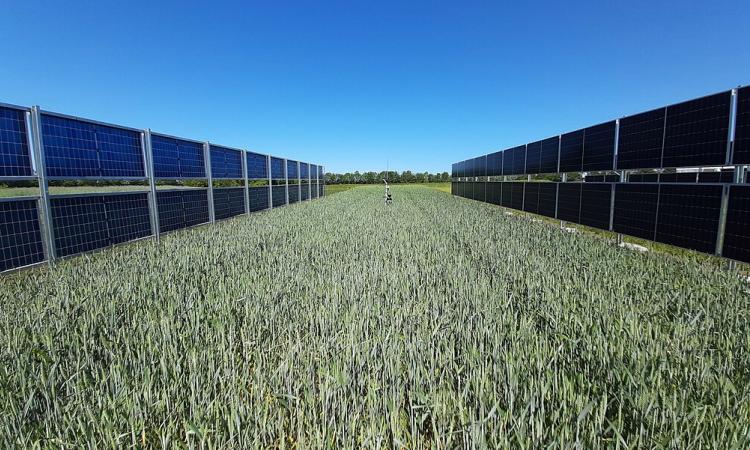
Agrivoltaics set to pick up in India due to tech and design innovations
Agrivoltaics, or harvesting crops and solar energy from the same plot of land, has been around in India for over a decade, but scalability remains a challenge. This is because India has adhered to the traditional understanding of agrivoltaics that involves simultaneous use of land for agriculture and solar PV power generation while other countries have updated their standards for agrivoltaics (APV).
Experts suggest that designing APV systems while ensuring good crop yields on land where the solar panels are installed, is one of the important ways to increase the acceptability of APV projects in India. Recent experiences from Maharashtra and New Delhi show that innovations related to land spacing are making agricultural activities such as ploughing and harvesting more feasible alongside solar installations.
These innovations that help increased distance between solar panel rows to integrated systems of rainwater harvesting, drip irrigation, and improved farm practices, could pave the way for widespread adoption of agrivoltaics in India (Mongabay, India).
Researchers develop a land conversion pressure map to help conservation planning
While human activities are increasingly modifying natural habitats worldwide threatening biodiversity, focused efforts need to be made to conserve threatened lands and preserve biodiversity when limited capital and resources are available for conservation. Thus, identifying areas undergoing degradation and habitat loss is crucial to prevent further deterioration of land.
Scientists at The Nature Conservancy, a United States-based think tank, and his team have created a Conversion Pressure Index (CPI) that offers an extensive perspective on potential land conversion risks across different ecosystems.
The team used human modification maps to assess the historical rate of human changes from 2000 to 2015 to forecast future alterations and found that human modification was expected to rise by 2030. They successfully pinpointed areas susceptible to further development based on existing infrastructure and resources such as renewable energy, oil and gas, mining, agriculture, and urban sector expansion. The CPI was validated by comparing it with the observed human modifications in 2015, showing a strong correlation between the modeled and observed maps.
The maps reveal that around 23 percent of land in 200 countries is under significant conversion pressure, affecting more than 460 million hectares of natural area and that industrial sectors are largely responsible for this. The CPI offers a reliable and spatially detailed tool for predicting future conversion pressures and can assist in identifying areas that need proactive conservation efforts (DownToEarth).
Hyderabad's water management to get smart
Hyderabad Metropolitan Water Supply and Sewerage Board (HMWSSB) will be replacing existing traditional water pipeline valves by automatic smart water valves to track and manage water distribution effectively as well as to prevent contamination in the water supply network.
The smart valves will have sensors that will be connected to the mobile devices of the linemen and officials concerned, aiding them to monitor water supply, duration and quality on a continuous basis. This information and the day to day activities will be connected to a dashboard and the system will be powered by solar panels. The technology is now being tested and will be evaluated for its effectiveness from the point of view of water flow and contamination.
The technology will be a boon for Hyderabad where 30 valves are installed for every 1000 to 2000 households in residential buildings and lineman are required to physically visit each pipeline value to release and close the water supply at regular intervals which makes the process time consuming and inefficient. The lineman has to take additional steps to monitor water supply and this makes the system inefficient and people often complain about lack of continuous water supply. Smart water values are expected to make the system more efficient and accountable (The Times of India).
A software engineer creates forests by planting trees in Pune and Bengaluru
Tormented on seeing a large number of beautiful green trees being chopped down in Bengaluru, Kapil Sharma a software engineer decided to do something about it. He began visiting government offices to understand his role and capacity as a citizen and started planting saplings on weekends. As more and more people started joining him he started SayTrees - a non-profit organisation dedicated to creating urban and rural forests, and rejuvenating lakes with support from corporations and the community.
The organisation also started working on water conservation after realising that after planting saplings during the monsoon, it became challenging to find water to sustain them in the summer.
The non-profit has planted 3.8 million trees across the country and rejuvenated six lakes and 40 wells in Bengaluru and Pune. Kapil attributes his success to finding the right purpose, the right people, and the right corporate partners for funding support and thinks that involving communities who are passionate about bringing about a change is the key to the success of the effort (The Better India).
A pioneering startup develops water from thin air
While Indian cities like Bengaluru have been struggling with the looming threat of acute water scarcity, a Bengaluru based startup has come up with a pioneering technology - to generate water from air. Uravu Labs, a pioneering startup uses atmospheric water or humidity that can be captured and bottled.
Scientists from Uravu lab inform that there is an average of two billion litres of water in the 100 metres of Bengaluru’s air column at any given time and harnessing this water could help to address the city’s drinking water crisis to some extent.
At Uravu Labs, air moisture is absorbed using a liquid desiccant and then processed through a desorption method to convert it into water. This water is purified and enriched with essential minerals and bottled for consumption. Uravu labs uses liquid desiccant instead of the more popular condensation technology which is both more affordable and efficient, currently producing over 4,000 litres per day (Mongabay, India).
This is a roundup of important news updates from August 1 to August 15, 2024. Read our policy updates here
/articles/agrivoltaics-set-gain-fresh-boost-india